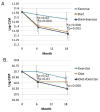Effects of dietary weight loss with and without exercise on interstitial matrix turnover and tissue inflammation biomarkers in adults with knee osteoarthritis: the Intensive Diet and Exercise for Arthritis trial (IDEA)
- PMID: 28756278
- PMCID: PMC5650925
- DOI: 10.1016/j.joca.2017.07.015
Effects of dietary weight loss with and without exercise on interstitial matrix turnover and tissue inflammation biomarkers in adults with knee osteoarthritis: the Intensive Diet and Exercise for Arthritis trial (IDEA)
Abstract
Objective: To examine the effects of dietary weight loss, with and without exercise, on selected soluble biomarkers in overweight and obese older adults with symptomatic knee osteoarthritis (OA).
Design: Blood samples were analyzed from 429 participants in the Intensive Diet and Exercise for Arthritis (IDEA) trial randomized to either an 18 month exercise control group (E), weight loss diet (D), or D + E. C1M, C2M, C3M and CRPM biomarkers and interleukin-6 (IL-6) were quantitated using ELISAs. Radiographic progression was defined as a decrease in joint space width of ≥0.7 mm. Statistical modeling of group means and associations used mixed models adjusted for visit, baseline body mass index (BMI), gender, and baseline values of the outcome.
Results: Compared to the E control group, C1M was significantly lower in the D and D + E groups at both 6 and 18 months while C3M was significantly lower in D and D + E at 6 months and in D + E at 18 months. C2M did not change in any group. Using data from all groups, change in C1M (P < 0.0001), C3M (P < 0.0001), as well as CRPM (P = 0.0004) from baseline to 18 months was positively associated with change in weight. No marker was associated with change in Western Ontario and McMaster Universities Osteoarthritis Index (WOMAC) pain or radiographic progression. C3M (P = 0.008) and CRPM (P = 0.028) were positively associated with change in WOMAC function. Change in IL-6 was positively associated with change in C1M, C3M, and CRPM.
Conclusion: Overweight and obese adults with knee OA who lost weight from diet and diet plus exercise reduced serum markers of interstitial matrix turnover and inflammation but not type II collagen degradation.
Trial registration: ClinicalTrials.gov NCT00381290.
Keywords: Biomarkers; Collagen; Exercise; Osteoarthritis; Weight loss.
Copyright © 2017 Osteoarthritis Research Society International. Published by Elsevier Ltd. All rights reserved.
Conflict of interest statement
Drs. Anne Bay-Jensen and Morton Karsdal are employees of and hold stock/stock options in Nordic Biosciences. Dr. Ali Guermazi holds stock/stock options in Boston Imaging Core Lab, LLC.
Figures


References
-
- Messier SP, Loeser RF, Miller GD, Morgan TM, Rejeski WJ, Sevick MA, et al. Exercise and dietary weight loss in overweight and obese older adults with knee osteoarthritis: The Arthritis, Diet, and Activity Promotion Trial. Arthritis Rheum. 2004;50:1501–1510. - PubMed
-
- Messier SP, Mihalko SL, Legault C, Miller GD, Nicklas BJ, DeVita P, et al. Effects of intensive diet and exercise on knee joint loads, inflammation, and clinical outcomes among overweight and obese adults with knee osteoarthritis: the IDEA randomized clinical trial. JAMA. 2013;310:1263–1273. - PMC - PubMed
-
- McAlindon TE, Bannuru RR, Sullivan MC, Arden NK, Berenbaum F, Bierma-Zeinstra SM, et al. OARSI guidelines for the non-surgical management of knee osteoarthritis. Osteoarthritis Cartilage. 2014;22:363–388. - PubMed
-
- Hochberg MC, Altman RD, April KT, Benkhalti M, Guyatt G, McGowan J, et al. American College of Rheumatology 2012 recommendations for the use of nonpharmacologic and pharmacologic therapies in osteoarthritis of the hand, hip, and knee. Arthritis Care Res. 2012;64:455–474. - PubMed
-
- Nelson AE, Allen KD, Golightly YM, Goode AP, Jordan JM. A systematic review of recommendations and guidelines for the management of osteoarthritis: The Chronic Osteoarthritis Management Initiative of the U.S. Bone and Joint Initiative Semin. Arthritis Rheum. 2014;43:701–712. - PubMed
Publication types
MeSH terms
Substances
Associated data
Grants and funding
LinkOut - more resources
Full Text Sources
Other Literature Sources
Medical

